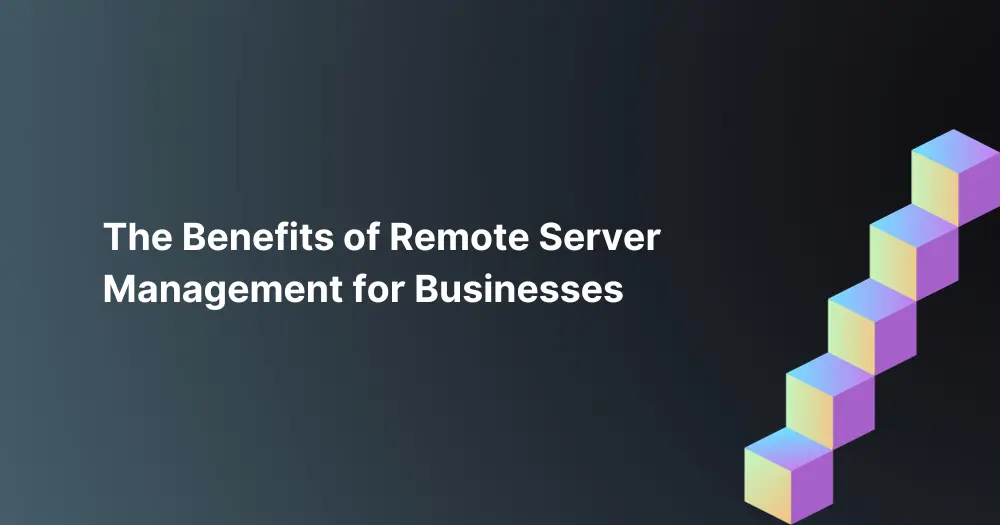
The era when IT was merely a back-office function is long gone. It has highlighted its importance year after year, playing a pivotal role in transforming how businesses operate. It has been seen that those who didn’t adapt to change have had tremendous disadvantages and hardly kept up with their competition. A robust IT infrastructure doesn’t just simplify processes—it also propels growth and innovation.
Navigating the intricate maze of IT systems has its challenges. Businesses frequently grapple with budget restrictions, looming cybersecurity risks, and the challenge of keeping pace with the rapidly changing tech world.
In a world where business operations are intricately entwined with digital technology, the term “Remote Server Management” has risen to prominence. We will guide you through the basics of remote server management and its benefits to make informed decisions before integrating it into your organizational framework.
Remote server management is far more than mere remote troubleshooting. It entails the remote supervision and maintenance of your organization’s servers to ensure uninterrupted functionality.
Why do you think this is such a pivotal topic? The reason is simple: servers are the backbone of your digital existence. It stores data, runs applications, and hosts websites. Its heavy role in your digital infrastructure, proactive management and maintenance is vital for business continuity and cybersecurity.
IT professionals utilize specialized software to access servers remotely to perform tasks such as monitoring system performance and providing real-time solutions to issues that may arise—all from the comfort of their own location.
What makes remote server management stand out is its automation capabilities. It shifts the paradigm from traditional, manual maintenance to an efficient, proactive, and automated approach. This transformative feature lets you automate routine tasks such as system updates, patches, and data backups, which are essential for server health and security. By systematically executing these tasks, automation reduces the potential for human error and ensures servers remain up-to-date and well-protected. Automated maintenance’s most notable advantage is reducing the IT staff’s workload, which allows them to focus on strategic projects that drive innovation and business growth. It transforms the IT department’s role from firefighting to forward-thinking, optimizing productivity and resource allocation.
Remote server management prioritizes continuous monitoring of your systems. Its real-time monitoring capabilities provide IT teams with a better understanding of how the system is performing. Your servers will be under constant surveillance, allowing immediate detection and resolution of issues. It can track performance metrics, identify bottlenecks, and proactively address issues before they escalate into significant problems. This process not only addresses issues but can also be used to optimize your systems for better performance.
Remote server management offers a dual approach to data protection: regular backups for data loss prevention and recovery options for system failures. Backing up data into a secure location ensures data recovery even if your primary servers are unavailable. At the same time, comprehensive disaster recovery plans ensure constant data accessibility and safety, even in catastrophic events or cyberattacks.
The remote server management’s data backup and recovery features ensure your data is consistently safe, accessible, and recoverable. It truly is a better choice for protecting critical data and ensuring business continuity than traditional methods.
Remote server management’s proactive threat detection offers an advanced layer of protection by identifying and neutralizing potential threats before they can inflict severe damage. This proactive approach contrasts traditional security methods that often react to threats after infiltration, potentially leading to data breaches and operational disruptions. It deploys advanced security measures, provides constant surveillance of server environments, and is easily adaptable to evolving cyber threats. This strategy minimizes business risks, protecting critical data and ensuring uninterrupted business operations by reducing the window of opportunity for malicious actors and providing a resilient security shield.
A significant disruptor of productivity and operations is downtime—the period when your systems or services are unavailable. Downtime results in halted operations, delays, and lost work hours, which can be costly for any business. Traditional server monitoring may be more susceptible to extended downtime with its reactive nature.
One of the most significant financial implications of downtime is revenue loss. It’s a concept that recognizes that every minute of system unavailability directly impacts productivity and the bottom line. When systems are down, sales transactions, customer interactions, and other revenue-generating activities are interrupted. Remote server management is designed to minimize these losses by swiftly addressing issues and ensuring that systems remain operational.
Businesses employing remote server management have seen substantial cost savings, notably lower hardware costs. This is due to the prolonged lifespan of your servers through efficient management and optimization, reducing the need for frequent updates and replacements. Efficient management and proactive maintenance help to prevent performance degradation and hardware failures.
As your business expands, the demand for scalable IT resources intensifies to accommodate more customers, data, and operations. Remote server management offers the agility to seamlessly adjust and expand IT resources in response to these evolving needs. It facilitates dynamic resource allocation, permitting the allocation and reallocation of server capacity, storage, and processing power in real time, ensuring that your IT infrastructure aligns with the current demands of your business. It also allows easy scale-up during peak periods, optimizing resource utilization and scale-down during less active times, maintaining cost efficiency.
With remote accessibility, you can manage your servers virtually from anywhere, breaking free from geographical constraints and enhancing convenience. Additionally, it ensures anytime availability, unrestricted by traditional work hours, permitting round-the-clock server oversight for seamless operations. This accessibility and flexibility become indispensable for business continuity, even in unforeseen circumstances like natural disasters, guaranteeing resilient server management beyond the limitations of physical access required by traditional methods.
BlackPoint IT is dedicated to helping businesses leverage the power of technology. Our team of IT experts is committed to delivering managed IT solutions that align with your business goals, providing a robust, secure, and efficient IT infrastructure. Trust us to protect your data, strengthen your systems, and drive your success. Schedule a consultation today!